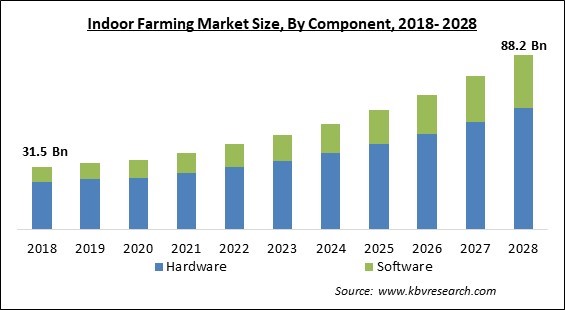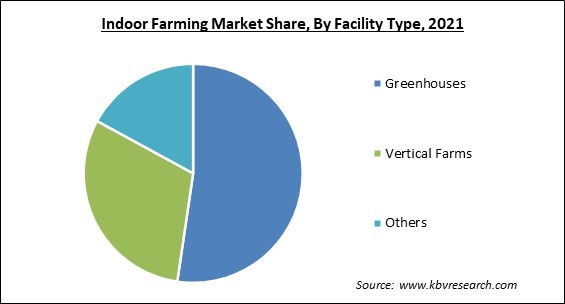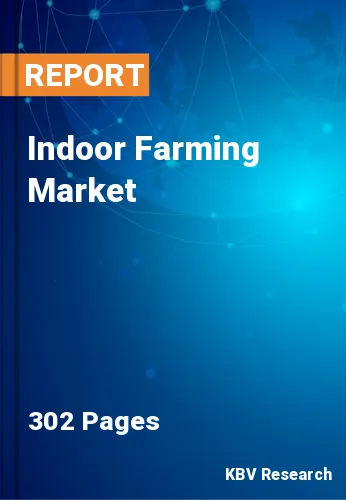The Global Indoor Farming Market size is expected to reach $88.2 billion by 2028, rising at a market growth of 12.7% CAGR during the forecast period.
Indoor farming is a technique of cultivating crops or plants exclusively indoors, usually on a big scale. Because of the water efficiency, limited land use, and benefits of controlled farming without any climate change, the indoor farming market is booming. The introduction of indoor farming has sparked global worries about the environmental consequences of traditional farming practices. Indoor farming is utilized to enhance local food supplies and provide consumers with fresh, nutritious veggies. The food produced using this method is particularly healthy since this sort of farming optimizes plant-fertilizing nutrients. A vast variety of crops, such as leafy vegetables, herbs, vegetables, fruits, microgreens, and flowers, can be grown inside.
Vertical farming inside produces organic food free of agrochemical pollution. These are the key driving factors behind indoor vertical farming, together with rising customer demand for pesticide- and herbicide-free vegetables.
One of the key advantages of indoor farming is that it produces more goods than traditional agricultural methods. Farmers benefit from indoor farming facilities because they can nurture a crop from seed to harvest in lesser time and with higher yields in each cycle while utilizing a lesser piece of land. According to USDA figures, greenhouse hydroponic tomatoes produced 10.59 pounds per square foot in 2016 in contrast to 1.85 pounds per square foot for traditionally grown tomatoes. As a result, indoor farms can increase overall crop output by assembling additional layers while expanding the growing land.
According to The World Bank Group, overall arable land per capita has decreased from 0.197 hectares in 2013 to 0.192 hectares in 2016. Due to the paucity of fertile land as a result of land degradation, farmers have been observing significant requirements to find innovative ways to produce fresh food. Indoor farmers would be able to produce crops indoors in layers piled on racks, in a multi-story building, or in a warehouse if vertical farming techniques are adopted.

The COVID-19 outbreak caused a significant downfall to various economies all over the world. The outbreak of the novel coronavirus slowed down numerous businesses globally. In addition, due to the rapid spread of the infection, governments all over the world were forced to impose countrywide lockdowns. Due to the travel restrictions under the lockdown, the supply chain of various goods, as well as intermediate goods, was significantly disrupted. Moreover, the lockdown also caused a considerable hindrance to various manufacturing facilities worldwide.
One of the main reasons for the declining yield is that cultivable area has been diminishing over time, in addition to unfavorable meteorological circumstances such as droughts, soil erosion, floods, and extensive pesticide use, all of which are reducing soil fertility globally, which is poses a huge concern. Increasing the yield and productivity of presently cultivated land is an alternative to generating more arable land. High-yielding varieties, fertilizer and pesticide control, mechanization, irrigation management, and the use of novel agricultural practices such as indoor farming are all examples of these technologies.
Many indoor farming technologies lack a long track record in the marketplace, and research is currently underway to determine the impact of these technologies on the shelf life of a plant. The impact of LED illumination on plants is considered to be beneficial for plants, and the results were positive. The technology is still in its infancy and needs to be refined before it can be considered ideally helpful and financially viable. Many indoor farming methods lack a long track record of commercial success, due to which, various research and developments activities are currently underway to determine the impact of these technologies on plant shelf life.
One of the most important elements of indoor farming is the availability of adequate funding in order to initiate the process. However, it is a very cost-efficient method, but the deployment of indoor farming tools and setup is initially very expensive. There is a requirement for major investment in implementing this approach. The lack of required funding is a very challenging situation that is disrupting the implantation of indoor farming set up all over the world. Finding an investor is a very challenging task in many agriculture-related firms, and this may pose a difficulty in production, resulting in fewer producers investing in indoor farming.

Based on Component, the market is segmented into Hardware (Lighting systems, Irrigation systems, Sensors, and Climate control systems) and Software (Web-Based and Cloud-Based). In 2021, the hardware segment witnessed the largest revenue share of the indoor farming market. Since hardware plays an important role in sustaining the atmosphere of indoor farms, this segment is observing considerable growth. Climate control systems, sensors, lighting systems, and irrigation systems are all part of the section, which enables the growing of indoor-grown crops. The temperature control system, which generates an environment favorable to plant growth is in higher demand. Chillers, air-conditioning units, heaters, humidifiers, and air movement fans are among the components that help control the indoor environment.
Based on Facility Type, the market is segmented into Greenhouses, Vertical Farms, and Others. In 2021, the vertical farm segment recorded a significant revenue share of the indoor farming market. The increasing growth of the segment is attributed to the lack of fertile land in the world. Due to the rapidly spreading industrialization, agricultural land is becoming infertile due to various toxic elements in the environment. Vertical farms can save a significant amount of farming space. Hence, the growth of the segment is surging.
Based on Crop Type, the market is segmented into Tomato, Lettuce, Bell & Chili Peppers, Strawberry, Leafy Greens, Herbs, Cucumber, Flowers & Ornamentals, and Others. In 2021, the flowers and ornamentals segment procured a significant revenue share of the indoor farming market. This segment is likely to contribute considerably to the increasing growth of the overall indoor farming market. The utilization of ornamentals and flowers for decorative and aesthetic purposes. Annuals, perennials, and ornamentals have been separated from the rest of the segment. Hence, due to the increasing sales of flowers along with other ornaments, the growth of the segment is flourishing.
| Report Attribute | Details |
|---|---|
| Market size value in 2021 | USD 38.8 Billion |
| Market size forecast in 2028 | USD 88.2 Billion |
| Base Year | 2021 |
| Historical Period | 2018 to 2020 |
| Forecast Period | 2022 to 2028 |
| Revenue Growth Rate | CAGR of 12.7% from 2022 to 2028 |
| Number of Pages | 302 |
| Number of Tables | 579 |
| Report coverage | Market Trends, Revenue Estimation and Forecast, Segmentation Analysis, Regional and Country Breakdown, Companies Strategic Developments, Company Profiling |
| Segments covered | Component, Facility Type, Crop Type, Region |
| Country scope | US, Canada, Mexico, Germany, UK, France, Russia, Spain, Italy, China, Japan, India, South Korea, Singapore, Malaysia, Brazil, Argentina, UAE, Saudi Arabia, South Africa, Nigeria |
| Growth Drivers |
|
| Restraints |
|
Based on Regions, the market is segmented into North America, Europe, Asia Pacific, and Latin America, Middle East & Africa. In 2021, Europe accounted for the largest revenue share of the indoor farming market. The growth of the market is attributed to the availability of a large proportion of the farming land. In this region, agriculture is an industry, which is employing a large number of regional people. Moreover, the growth of the regional market is also due to the increasing adoption of indoor farm technology like Controlled Environment-Agriculture, which controls the environmental component. The market is being driven by a growing focus on adopting technology like active heat systems and LEDs to boost yield.
Free Valuable Insights: Global Indoor Farming Market size to reach USD 88.2 Billion by 2028
The market research report covers the analysis of key stake holders of the market. Key companies profiled in the report include Orbia Advance Corporation, Certhon, General Hydroponics, Hydrodynamics International, Argus Control Systems Limited, Priva BV, LumiGrow, Inc., Richel Group, and Vertical Farm Systems Pty Ltd.
By Component
By Facility Type
By Crop Type
By Geography
The in indoor farming market size is projected to reach USD 88.2 billion by 2028.
Shortage of fertile land are driving the market in coming years, however, inefficient funding in the sector growth of the market.
Orbia Advance Corporation, Certhon, General Hydroponics, Hydrodynamics International, Argus Control Systems Limited, Priva BV, LumiGrow, Inc., Richel Group, and Vertical Farm Systems Pty Ltd.
The Greenhouses segment acquired maximum revenue in the Global Indoor Farming Market by Facility Type in 2021, thereby, achieving a market value of $45.0 billion by 2028.
The Tomato segment is leading the Global Indoor Farming Market by Crop Type in 2021, thereby, achieving a market value of $21.9 billion by 2028.
The Europe fastest growing region in the Global Indoor Farming Market by Region in 2021, and would continue to be a dominant market till 2028.
Our team of dedicated experts can provide you with attractive expansion opportunities for your business.

